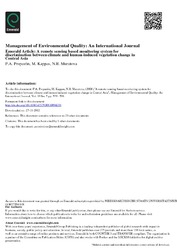A remote sensing based monitoring system for discrimination between climate and human-induced vegetation change in Central Asia
Propastin, P. A.
Kappas, M.
Muratova, N. R.
19, 5: 579 - 596
DOI: https://doi.org/10.1108/14777830810894256
Persistent URL: http://resolver.sub.uni-goettingen.de/purl?gldocs-11858/6995
Persistent URL: http://resolver.sub.uni-goettingen.de/purl?gldocs-11858/6995
Propastin, P. A.; Kappas, M.; Muratova, N. R., 2008: A remote sensing based monitoring system for discrimination between climate and human-induced vegetation change in Central Asia. In: Propastin, P.A.; Kappas, M.; Muratova, N.R. (2008): A remote sensing based monitoring system for discrimination between climate and human-induced vegetation change in Central Asia, DOI: 10.1108/14777830810894256.
 |
Dokument öffnen: |
Purpose – This paper aims to demonstrate the importance of taking into account precipitation and
the vegetation response to it when trying to analyse changes of vegetation cover in drylands with high
inter-annual rainfall variability.
Design/methodology/approach – Linear regression models were used to determine trends in
NDVI and precipitation and their interrelations for each pixel. Trends in NDVI that were entirely
supported by precipitation trends were considered to impose climate-induced vegetation change.
Trends in NDVI that were not explained by trends in precipitation were considered to mark
human-induced vegetation change. Modelling results were validated by test of statistical significance
and by comparison with the data from higher resolution satellites and fieldtrips to key test sites.
Findings – More than 26 percent of all vegetated area in Central Asia experienced significant
changes during 1981-2000. Rainfall has been proved to enforce most of these changes (21 percent of the
entire vegetated area). The trends in vegetation activity driven by anthropogenic factor are much
scarcer and occupy about 5.75 percent of the studied area.
Practical implications – Planners, decision makers and other interest groups can use the findings
of the study for assessment and monitoring land performance/land degradation over dry regions.
Originality/value – The study demonstrates the importance of taking into account precipitation and
the vegetation response to it when trying to analyse changes of vegetation cover in drylands with high
inter-annual rainfall variability.
Statistik:
ZugriffsstatistikSammlung:
- Geologie [930]

